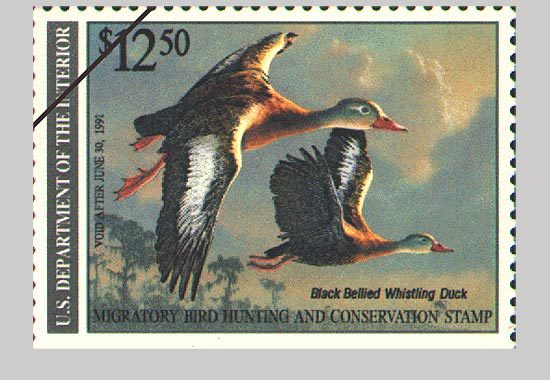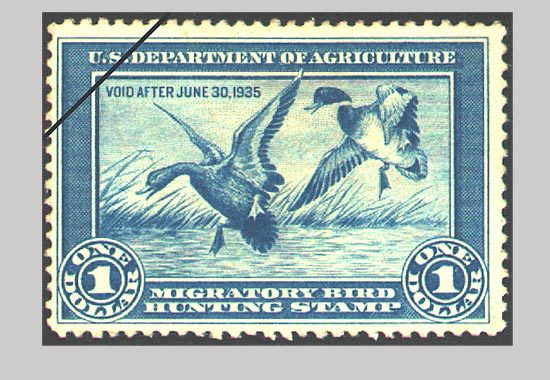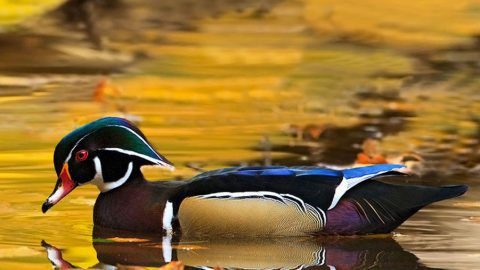Eight Great Reasons to Love the Migratory Bird Stamp
Not just for hunters, the Duck Stamp has raised more than $1 billion for conservation, helped birds from Buffleheads to Bobolinks, and created a wealth of fine art in the process. Buying a Duck Stamp is a positive conservation action any birder can take.
July 30, 2024
Originally published July 2014; updated July 2024.
Among the U.S.’s many spectacular federal and state lands, it pays to remember the wildlife havens that are the National Wildlife Refuge system, administered by the U.S. Fish and Wildlife Service. This system of more than 500 areas is managed primarily for the benefit of wildlife, and they are great places to see birds of all kinds, including waterfowl, shorebirds, and songbirds.
One of the best ways to support National Wildlife Refuges is to buy a Migratory Bird Hunting and Conservation Stamp, or “Duck Stamp,” every year. It’s a win-win-win: it proudly proclaims your support of public land, it funnels money directly to the refuge system (to the tune of some $40 million per year), and it gets you free entry to the refuges all year.
Buying a Migratory Bird Stamp is a simple and direct way for people to contribute to grassland and wetland conservation. In 2013, the New York Times ran a piece on the annual stamp art competition; now here’s our own list of eight reasons to love the stamp:
1. Over $1 billion for conservation and counting. The first stamp was issued in 1934. It cost $1 (about $18 in today’s dollars) and sold 635,001 copies. By law, the funds raised go directly to habitat acquisition in the lower 48 states. By now, stamp sales have surpassed $1 billion and helped to protect 6.5 million acres of wetland and grassland habitat.
2. A 73-year tradition of beautiful wildlife art. The Migratory Bird stamp is a beautiful collectible and a great artistic tradition. Since 1949, the design of each year’s duck stamp has been chosen in an open art contest. The 2022 stamp, showing a pair of Redheads, was painted by James Hautman, a veteran of the contest who now has six wins to his name (see a gallery of all stamps back to 1934).
3. A bargain at $25. Ninety-eight cents of each dollar spent on a stamp goes directly to land conservation for the National Wildlife Refuge System. This $25 purchase is perhaps the single simplest thing you can do to support a legacy of wetland and grassland conservation for birds.
4. It’s much more than ducks. Waterfowl hunters have long been the main supporters for the program—the stamps are a requirement for anyone 16 or older who wants to hunt. But the funds benefit scores of other bird species, including shorebirds, herons, raptors, and songbirds, not to mention reptiles, amphibians, fish, butterflies, native plants, and more. (See a full illustrated history of how the Duck Stamp helped save North American waterfowl, from Bird Academy.)
Related Stories
5. Save wetlands; save grasslands. Since 1958, the U.S. Fish and Wildlife Service has used stamp revenues to protect “waterfowl production areas”—over 3 million acres—within the critical Prairie Pothole Region. The same program also protects declining prairie-nesting birds in the face of increasing loss of grasslands. As a result, refuges are among the best places to find grassland specialties such as Bobolinks, Grasshopper Sparrows, Clay-colored Sparrows, Sedge Wrens, and others.
6. The benefits are gorgeous. Some of the most diverse and wildlife-rich refuges across the Lower 48 have been acquired with stamp funds. Chances are there’s a wildlife refuge near you that has benefited.
7. It’s your free pass to refuges. A migratory bird stamp is a free pass for an entire year to all refuges that charge for admission—so your $25 could even save you money.
8. As birdwatchers, let’s get in on the secret. Though it’s long been a fixture in hunting circles, the Migratory Bird Hunting and Conservation Stamp is one of the best-kept secrets in all of bird conservation. It’s time to buy and show your stamp!
(Thanks to the Friends of the Migratory Bird/Duck Stamp for help in preparing this post.)

All About Birds
is a free resource
Available for everyone,
funded by donors like you
American Kestrel by Blair Dudeck / Macaulay Library


















